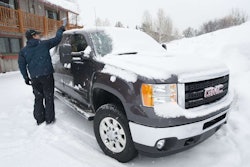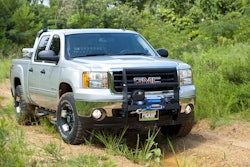Power Plays
Whether traveling cross-country or to a local jobsite, I’m always looking for a place to plug in my 110V electronic devices like small coolers, microwaves, laptops, printers and battery chargers. Contractors of all trades working in the field know finding places to plug in such accessories can be scarce.
 Go Power’s GP-300 Modified Sine Wave inverter is an easy solution for small power loads. This unit can power lights and TVs, phone chargers and camera chargers.
Go Power’s GP-300 Modified Sine Wave inverter is an easy solution for small power loads. This unit can power lights and TVs, phone chargers and camera chargers.
That’s where power inverters are a real benefit for the mobile office.
An inverter works like a battery charger in reverse: It converts the pickup’s DC battery power to household (AC) current, which allows you to operate AC-powered devices in your vehicle.
Power inverters are such a handy feature that many of the newer pickups now feature 115V AC outlets in the dash and behind the center console. But these small (150W) inverters may not be stout enough to handle your business and recreation needs.
So plugging in to an aftermarket inverter that can provide up to ten times that power is the next step.
GETTING ENOUGH POWER
Choosing an inverter involves finding one that can supply the watts required to run the accessories, getting the right kind of power, and selecting the features you want to see in your power supply.
 Cobra’s CPI 1575 1,500 Watt Power Inverter unit is ideal for appliances such as microwave ovens (1,000 watts or less), coffeemakers, laptops, TV sets, video games, CD players, DVD players, cellular phone chargers and much more.
Cobra’s CPI 1575 1,500 Watt Power Inverter unit is ideal for appliances such as microwave ovens (1,000 watts or less), coffeemakers, laptops, TV sets, video games, CD players, DVD players, cellular phone chargers and much more.
First, select an inverter that has enough “continuous” output to give you some electrical headroom to accommodate future power needs. Check each of your accessories’ product labels or manuals for actual wattage numbers. Tally the numbers and plug in an extra 100 watts for good measure.
Some inverters are designed to plug in to the 12V outlets in your pickup. Their power, in terms of watts, available from such plug-in inverters is limited by: 1) the capacity of the inverter; 2) the wiring behind the pickup’s 12V power point; and 3) the fuse in this part of the pickup’s power system.
The higher-output inverters are usually hard-wired directly to the pickup’s battery.
Wiring kits are available from suppliers such as Go Power Electric (gpelectric.com) and Power inverters (powerinverters.org) that include proper gauge wiring, a fuse block and tie downs to mount the inverter in a permanent location inside the cab.
Under-seat locations are ideal as they are both out of the way and allow enough of an air gap surrounding the unit to provide sufficient cooling when the inverter is hard at work.
THE correct sine
There are two types of sine waves that an inverter can output: Modified Sine Wave or Pure (or true) Sine Wave. These names stem from the difference in how the energy waves look in an oscilloscope, a tool used to graph varying voltage signals.
Modified Sine Wave is a common output produced by basic inverters and is fine for many tools and other products powered by 110V/120V AC.
But for the mobile office needs a Pure Sine Wave inverter, which is very similar to the power from the grid, is the one you need to ensure laptops, high-end audio equipment and battery chargers for cordless tools function properly.
A Pure Sine Wave inverter can be significantly more expensive than a Modified Sine Wave model, however if your device requires it, it’s the only way to go.
Note: Not all electrical accessories can run off an inverter. Makita, for example, says you can’t use any type of inverter (Pure or Modified) to charge batteries for their cordless tools. So again, look into the requirements for the specific devices you wish to power with an inverter.
VALUABLE FEATURES
If the inverter you are considering doesn’t have enough outlets, a splitter won’t help. You’ll need a bigger unit. In addition to more AC outlets on a higher-output inverter, look for auxiliary power ports such as USB ports or an iPod quick-charge interface adaptor.
If power used from an inverter involves possible exposure to water, it should be equipped with a GFCI outlet to instantly protect against a ground fault.
Inverters: Mobile power to keep you energized when you are off the grid.
Inverters with digital readouts are also nice because they can provide you with information about the remaining voltage in the battery supply power; inform you of the current usage of the inverter, which allows you to monitor the rate of battery drain; and even alert you it’s time to start the engine of the vehicle to recharge the source battery.
Most include features to monitor and prevent DC voltage overload before it can damage the inverter.
SAFETY first
As mentioned earlier, power inverters create heat, so thermal-overload protection and a variable-speed fan help to keep the unit within proper temperature range.
(On lower-wattage models with passive cooling, it is important to mount the unit in a location and in an orientation that will give it proper ventilation.)
Inverters can use some amperage even when they are not in use, so a remote switch to disconnect the inverter from the battery should be installed on a vehicle that won’t be operated for a while.
Inverters are great tools for the contractor. So if your pickup doesn’t have AC outlets, or the factory inverter is too small to handle your electrical requirements, step it up with one that has what you need to get the job done.
MORE POWER TIPS
A great resource for matching an inverter to your needs is donrowe.com; (800) 367-3019. Tell them what you want your inverter to do and they can hook you up.
More power often means more alternator to replace battery power. An alternator upgrade can also help your pickup run onboard compressors and winches.
Heavy inverter use can call for a battery upgrade. Optima’s Yellow Top provides excellent cranking power plus oustanding cycling capability (rechargeability), which is perfect for accessory-loaded vehicles. Optima Batteries; optimabatteries.com







